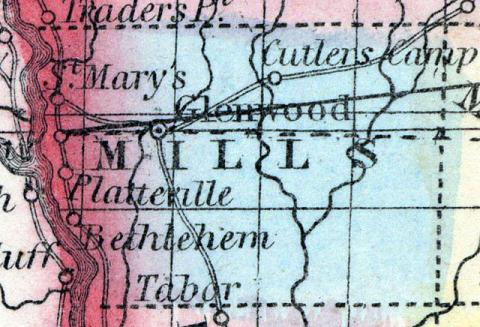GLENWOOD, the seat of justice of Mills County, was so named by act of the General Assembly, approved 12th January, 1853, and the seat of justice also permanently located here. It was incorporated as a City by special act approved January 17, 1857, and has ever since preserved her city organization. It is most beautifully located a few miles west of the geographical centre of the county, in the valley of Keg Creek, surrounded by a growth of large timber. A young growth on the town site furnishes beautiful shade trees, and the neat cottages nestled in and among the shady groves furnish a happy contrast with the prairie towns. The site itself is very suggestive of the name “Glenwood.” It is six miles to the landing on the Missouri River, with a perfectly level road, and consequently while Glenwood lays little claim to being a commercial metropolis her close proximity to the River makes her communication easy with the commercial world. In the spring of 1848 the town site of our present Glenwood was first settled by Libeus T. Coon, Silas and Ira Hilman, William Brittain, G. N. Clark and others, who have all passed from our view except Mr. Brittain. The first house erected in Glenwood was built at the northeast corner of the present town site, and was destroyed by fire about four years ago. The next one, erected almost simultaneously, still remains the glory and pride of our primitive architecture. It is the low, slab-roofed ten-by-twelve log cabin standing in the rear of the “Bett's House,” on Mr. Mewes' lot. In this house it is said the first school was taught in Glenwood—our fellow citizen D. H. Solomon playing the pedagogue. William Coolidge is said to be the first white child born in Glenwood—in December, 1849. Probably the first death was that of the wife of Silas Hilman, who died in the summer of 1849. There are three church buildings in Glenwood, two brick and one frame—the M. E. church owning the frame building, while the Congregational and Baptist societies each have a brick house of worship. The Christian denomination have also an organized society. A large brick school house was erected in the summer of 1856 for the use of the public schools, but its capacity has long since failed to accommodate the increased number of scholars, and the Independent School District of Glenwood has now in course of construction a brick Union School House at an estimated cost of ten thousand dollars, to be completed by the fall of 1866, which will add a new interest to this already thriving town. A mammoth Court House of brick, costing about forty thousand dollars, adorns the public square. The Glenwood Lodge, A. F. & A. M., No. 58, meets regularly every 3d Saturday evening in each month. Glenwood Lodge I. O. O. F., No. 97, meets every Thursday evening. Glenwood Lodge I. O. G. T., No. 125, meets every Monday evening. The Glenwood weekly Opinion, furnishes, every Saturday morning, news from all the world, published by T. P. Ballard, formerly of the Iowa City Republican. (Hair's Iowa State Gazetteer..., 1865)

